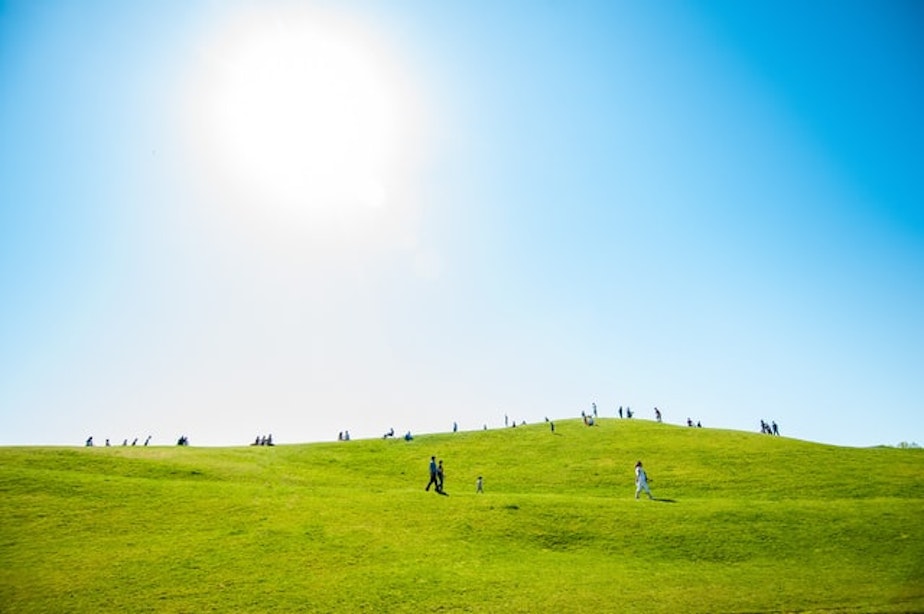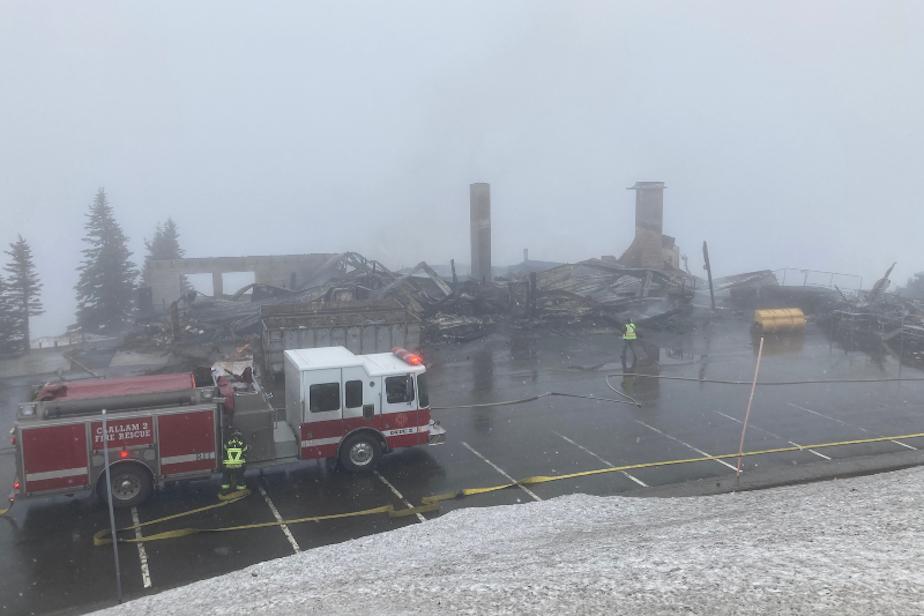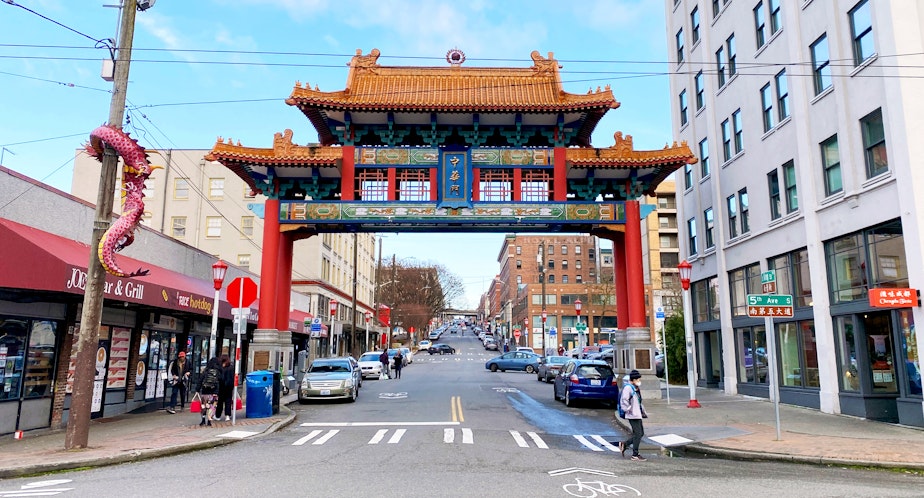How hot will it get around the Seattle area this weekend? Today So Far

- Seattle-area weather is about to heat up. But how hot it will get depends on where you are located.
- We're about to go through another pandemic transition.
- Seattle is nixing right turns at many red lights in downtown, but the city likely won't stop there.
This post originally appeared in KUOW's Today So Far newsletter for May 9, 2023.
If you're like me, you are ready to get out your umbrella — the sun is out, and it's about to get hot. Yes, I just said that. I've gotten over my shame about using an umbrella to shield myself from the vile sun like a modern vampire (hisss!).
We've had a recent warm stretch, but even higher temps are in the forecast for later this week. Parts of Western Washington are likely to experience temperatures above 80 degrees this weekend, even 90 degrees.
The forecast is changing daily. Some say Sunday will be the hottest, others say Monday. This also depends on where you are located. It's looking less and less likely that Seattle and some other areas will hit 90 degrees. As of this morning, however, the forecast for places like Renton, Olympia, Tacoma, and my neighborhood, states that the 90 degree mark could be reached Sunday/Monday.
The National Weather Service reports that it's normal for Seattle to get a couple of days above 80 degrees in May. Seven days were above 80 in 1958, which is the record. Seattle has never experienced a 90-degree day before May 17 (which happened in 2008). So if the city (or Sea-Tac Airport where the official weather records are taken) hits 90 degrees this weekend, it would set a new record (weather records go back to 1945 at Sea-Tac). Read more here.
The forecast comes amid a few other weather headlines. April was one of the coldest on record. Still, an El Niño season is expected this summer, which generally means warmer than normal sea temperatures, and in turn, warmer and drier conditions in our area. Then again, as KUOW's John Ryan reports, despite warming ocean waters globally, West Coast waters have recently stayed cooler than the 30-year average.
I recently got an unexpected letter in the mail from my insurance company. Folks around Washington have likely received something similar. In short, it was an update about pandemic-related services and coverage. This is because the USA is about to go through a transition of sorts. It sounds like a big deal, but really, it's an organizational change. A lot of services that were covered by the government the past few years will now be covered by insurance companies. Things like vaccines, treatments, and tests.
"It's not as if you're going to wake up on May 12 and the ability to access vaccines, or therapeutics or tests etc. will all of a sudden not be there," Washington's Secretary of Health Dr. Umair Shah recently said.
It's probably worth noting that, while I write above, this as an "organizational handoff" from the government to insurance companies, things could be different for folks without insurance.
Seattle and Washington state ended their Covid emergencies in late 2022. The World Health Organization ended its own Covid emergency declaration last week, noting that Covid has been on a downward trend globally, allowing "most countries to return to life as we knew it before Covid-19." It should be noted that some experts estimate another omicron-level surge is possible within the next couple years, but the level of probability around that varies (5-30%). The University of Washington will end its own Covid vaccine requirement for students and staff on June 12. This also means that the university will end its contact tracing and notification policy. Students and staff will no longer be required to report positive Covid cases.
On Thursday, the federal Covid public health emergency will expire, which is why all those insurance letters have been sent out. KUOW's Kate Walters has been covering this transition for a couple weeks now. She recently noted that this Thursday will officially close the chapter on the Covid pandemic. History books will state that it lasted three years, three months and 11 days. But just like the infamous 1918 flu, the Covid pandemic will not truly be ending soon. It's going to be with us, seasonally. So will booster shots, and mutations, etc. Generations will grow up with it, just as we all grew up hearing about the flu.
"The end of the public health emergency means that, as a society, we are transitioning our Covid-19 response from an emergency response phase to a new phase,” Dr. Tao Sheng Kwan-Gett with Washington’s Department of Health told KUOW. “And it's important for us to remember that the pandemic is not over and that Covid-19 will be here for the foreseeable future."
A warning for Seattle drivers: Double check before you turn right at a red light in the city. Seattle is increasing the number of intersections where it prohibits turning right on red, mostly in downtown ... for now. A closer look at the city's new policy around nixing the red-light turns shows that there is potential to expand this across the city.
The city already didn't allow right-on-red turns at about 100 intersections. At the start of 2023, it began converting a total of 41 more intersections. The Department of Transportation expects to have all new signs up forbidding the right turns by July. A violation could cost drivers $139.
"There's about 1,000 signal light intersections in Seattle, approximately 100 already had this treatment ... I'm really interested in exploring this in the U-District, which has got students walking everywhere," SDOT Director Greg Spotts told "Seattle Now" this morning. "An interesting thing we're finding is that people from other neighborhoods are raising their hands, saying, 'Well, when are we getting no-right-on-red in our pedestrian-dense intersections.' And I think that is very exciting, the idea that we can work with communities to roll this out farther."
I'm just going to say that I highly doubt any average Seattleite is throwing around the term "pedestrian-dense intersections" in general conversations. I think our SDOT director slipped into some wonky talk on that one.
Spotts says that the original idea behind allowing right turns at red lights historically had more to do with saving gas than safety. He says that he is moving SDOT away from "1970s concepts of traffic engineering where the flow of cars is the number one important thing." Instead, he argues, the safety of grandparents and kids is the most important thing. He also notes that during the pandemic, in Seattle and nationally, the number of people killed and seriously injured on streets went up.
Currently, there is not formal process for Seattle residents to nominate other intersections for a no-turn-on-red sign. But Spotts says that he's interested in hearing more from the community about areas that could be good for it.
Read more here and check out today's "Seattle Now" here.
AS SEEN ON KUOW

The Hurricane Ridge Day Lodge, a popular destination in Olympic National Park, caught fire Sunday, May 7. Park officials say the structure appears to be a complete loss. (National Park Service)
DID YOU KNOW?
Until last month, there was a "Swastika Mountain" on the Oregon map.
Over the years, people have submitted alternate names for the 4,200-foot mountain to the U.S. Board on Geographic Names and the Oregon Historical Society, such as "Umpqua Mountain" since it's in the Umpqua National Forest. On April 13, the Board ended up going with another suggestion, "Mount Halo," in honor of Chief Halito of the Yoncalla Kalapuya tribe.
The history of the mountain's original name has no ties to what you're likely thinking — there is no connection to Nazis or WWII. This gets into the larger history of the symbol, which goes back as far as 7,000 years, and is found in ancient Sanskrit. It was used by cultures across the globe. The Nazi Party didn't invent the symbol, but today, it's hard not to connect the two. In 1900, when the Oregon town of Swastika was established, along with the neighboring Swastika cattle ranch, residents had the original meaning in mind, which was "good fortune." The town and ranch are long gone now, but the nearby mountain still had the name associated with it. A local told NPR that residents in the area are aware of the pre-WWII history of the name, but many still felt it wasn't appropriate today.
ALSO ON OUR MINDS

Here's the latest list of the '11 Most Endangered Historic Places' in the U.S.
The National Trust has generated a list of endangered historic places since 1988 to draw attention to places in danger of being torn down or irreparably damaged. Two of this year's sites are historic Chinatowns on opposite sides of the country. Philadelphia's Chinatown dates back to 1871. Seattle's Chinatown-International District cannot be traced to a specific year of origin, but it's one of the oldest Asian-American neighborhoods on the West Coast.

